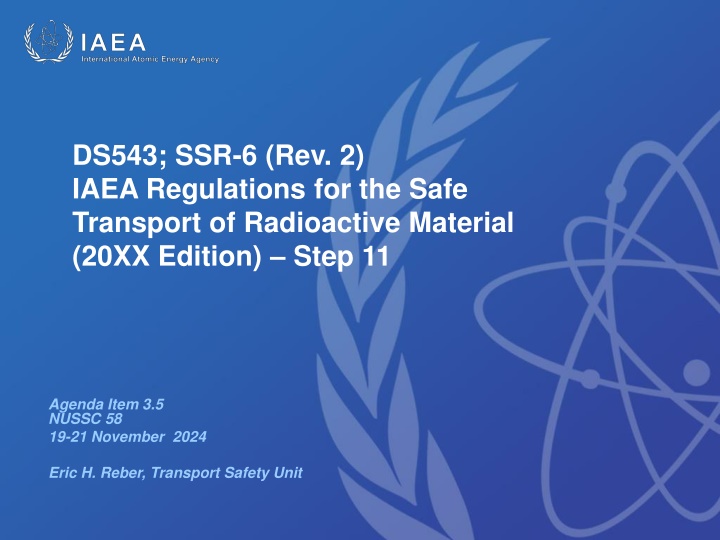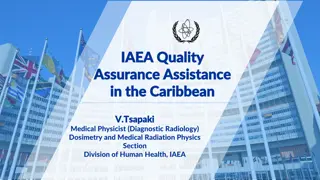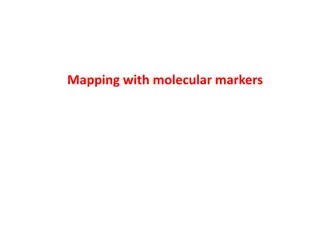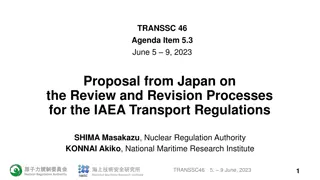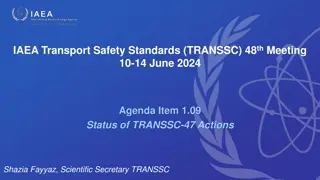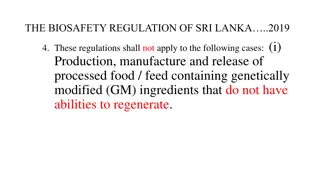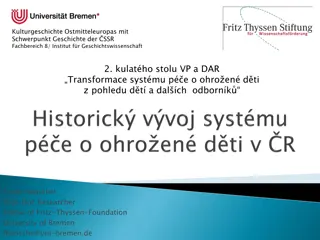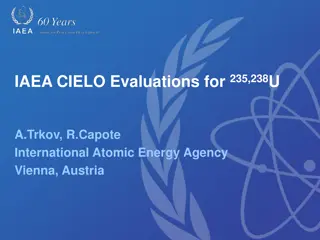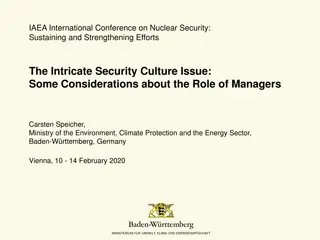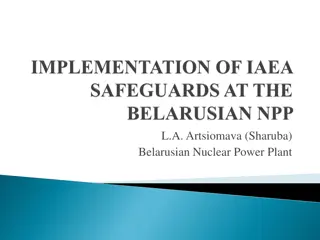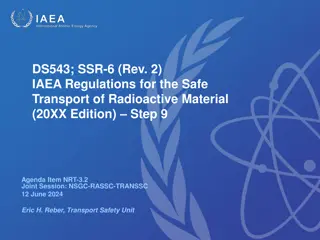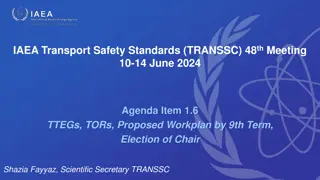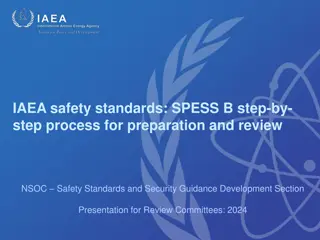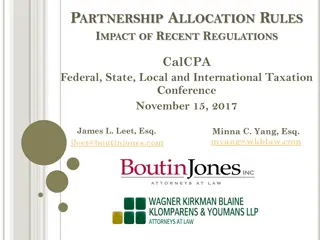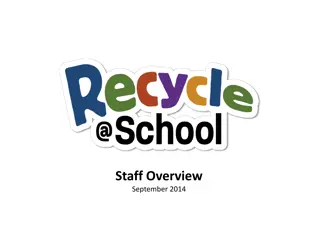IAEA Regulations SSR-6 Overview
IAEA Regulations SSR-6 provide safety guidelines for transporting radioactive material by land, water, and air to protect people and the environment from harmful effects of ionizing radiation. This includes establishing requirements for safe transport and incorporating SSR-6 into international regulatory frameworks.
Download Presentation

Please find below an Image/Link to download the presentation.
The content on the website is provided AS IS for your information and personal use only. It may not be sold, licensed, or shared on other websites without obtaining consent from the author.If you encounter any issues during the download, it is possible that the publisher has removed the file from their server.
You are allowed to download the files provided on this website for personal or commercial use, subject to the condition that they are used lawfully. All files are the property of their respective owners.
The content on the website is provided AS IS for your information and personal use only. It may not be sold, licensed, or shared on other websites without obtaining consent from the author.
E N D
Presentation Transcript
DS543; SSR-6 (Rev. 2) IAEA Regulations for the Safe Transport of Radioactive Material (20XX Edition) Step 11 Agenda Item 3.5 NUSSC 58 19-21 November 2024 Eric H. Reber, Transport Safety Unit
Presentation Overview Objective and Scope of SSR-6 International regulatory framework for transport safety Review/Revision Policy Review Cycle Revision Cycle (SPESS) Step 8: Soliciting comments by Member States Step 9: Addressing comments by Member State Step 10: Second internal review of the draft publication Step 11: Second review of the draft publication by the Review Committees Update of the Q system/ correction of A1/A2values; Justification paper TRANSSC 49 Process Request for second approval
Objective and Scope of SSR-6 The objective of SSR-6 (Rev. 1) is to establish requirements that must be satisfied to ensure safety and to protect people, property and the environment from harmful effects of ionizing radiation during the transport of radioactive material. SSR-6 (Rev. 1) applies to the transport of radioactive material by all modes on land, water, or in the air. Transport comprises all operations and conditions associated with, and involved in, the movement of radioactive material.
International Regulatory Framework for Transport Safety 193 signatories Incorporation of SSR-6 into the Model and Modal Regulations Model regulations for all dangerous goods 192 signatories Class 7 All modes Air Mail 167 signatories Sea Land transport Road, Rail and Inland Waterway Regional: MERCOSUR/MERCOSUL (4) ADR (54), RID (51), ADN (17) 4
Policy for reviewing and revising the Agencys Transport Regulations [Board of Governors (GOV/2005/31)] Transport regulations reviewed every two years the decision on the revision and publication will be made based on the assessment of TRANSSC/CSS If TRANSSC considers that a proposal for change stemming from a review cycle is sufficiently important for safety to necessitate publication as soon as possible, the Secretariat will initiate the revision process
Graphical Overview of the Review Process Proposals for change received by the Secretariat Initial review of proposals for change by TTEGs Recommendations by TTEGs to TRANSSC: accepted rejected impact on safety comments Recommendation / Decisions process for each individual proposal for change using the secondary set of questions in Annex 1 TRANSSC decisions: accepted rejected impact on safety Decision based on whether the aggregate of the accepted proposals would amount to a change in requirements that is important in terms of safety using the primary set of questions in Annex 1 TRANSSC decision on whether to revise SSR-6 (Rev. 1)
Overview of Proposals for Change 306 proposals received from Australia(3), Belarus(5), Belgium(1), Canada(10), France(70), Germany(11), IATA(12), ISO(3), Italy(7), Japan(17), Morocco(7), Oman(3), Pakistan(2), Russia(11), Sweden(15), Switzerland(28), WNTI(79), TIC(5), UK(8), USA(6) 294 unique proposals were assigned to primary TTEGs: TTEG Primary TTEG-C TTEG-OM TTEG-PPA TTEG-RP 37 177 62 18
Decision at TRANSSC 45 (Nov./Dec. 2022) to enter a Revision Cycle Based on the presentations and understanding of the TTEG recommendations to TRANSSC for each change proposal, coupled with the outcomes from the moderated discussions, roughly 75 change proposals were identified that would be addressed/acted on during the revision process. In summary, there was nearly unanimous support from the Member States to move into the revision of SSR-6 (Rev. 1).
Activity Start End 18 August 2022 STEP 1: Preparation of DPP July 2022 STEP 2: Internal review of the DPP (Approval by the Coordination Committee) 11 August 2022 18 August 2022 STEP 3: Review of the DPP by the Review Committees 26 August 2022 2 December 2022 STEP 4: Review of the DPP by the CSS (approval by CSS) 23 March 2023 23 May 2023 Revision Cycle Overview STEP 5: Development of revised manuscript of SSR-6 (Rev. 2) December 2022 24 July 2023 STEP 5*: Development of modified text for proposals that were designated as Accepted, but modified during T-45 December 2022 20 April 2023 STEP 5**: Review of revised text at TRANSSC 46 5 June 2023 9 June 2023 STEP 6: First internal review of SSR-6 (Rev. 2) (Approval by the Coordination Committee) 24 July 2023 24 August 2023 STEP 7: First approval of the draft publication by the Review Committees 31 August 2023 December 2023 STEP 8: Soliciting comments by Member States December 2023 May 2024 STEP 9: Addressing comments by Member States April 2024 July 2024 STEP 10: Second internal review of the draft publication (Approval by the Coordination Committee) July 2024 August 2024 STEP 11: Second review of the draft publication by the review Committee(s) (Approval of the draft) STEP 12: Editing of draft in MTCD and endorsement of the draft by the CSS, establishment by the Publications Committee and editing September 2024 December 2024 December 2024 April 2025 STEP 12*: Silence approval of the final edited text by TRANSSC STEP 13: Approval by the Board of Governors STEP 13*: Submittal of SSR-6 (Rev. 2) to UNECE STEP 14: Publication May 2025 June 2025 October 2025 October 2025 May 2025 September 2025 March 2026 January 2026
Step 8: Soliciting comments by Member States Note Verbale that solicited comments was issued on 3 January 2024 with a deadline of 8 May 2024 In accordance with the 2021 Transport Regulations Revision Quality Plan, only proposals that were submitted before the deadline of 18 March 2022 in response to the 5 November 2021 NV would be considered in the Revision Cycle. Table 2 of the draft SSR-6 (Rev. 2): included changes to A1/A2 values that are based on the results of the work of the TRANSSC s A1/A2 WG. Comments were requested concerning corrected A1/A2 values - Do you have any specific comments in relation to the justification for, or impact of, the proposed revised values? 285 Official comments received from Argentina (1), Australia (12), Belgium (3), Canada (13), Finland (1), France (62), Germany (54), Israel (3), Jamaica (5), Japan (33), Oman (9), Pakistan (16), Russia (9), Sweden (3), United Kingdom (19), United States (7), Switzerland (7), ISO (3), ISSPA (2), WNTI (23)
Step 9: Addressing official comments by Member States Draft resolution table and revised draft SSR-6 (Rev. 2) were developed during a consultancy meeting on 20 24 May 2024. In advance of the TRANSSC/RASSC meetings in June, files were uploaded to the respective folders of these committees for information . TRANSSC-48: Feedback received TTEG-C on RUS-5, and from TTEG- RP on A1/A2/Table 2 issues, i.e. ARG-1, JPN-03, AUS-1, CDN-04, GER- 8, FR-23, WNTI-02, USA-2 and UK-3. Concerning the proposed resolution of official comments, feedback was received from/ discussions held with representatives from: Germany, Israel, Japan, Switzerland, UK and WNTI Member States comments Resolution table and DS543 were revised, as appropriate, in response to the feedback received.
Step 10: Second internal review of the draft publication Comprehensive textual review of the draft performed by standards specialists in NSOC-SSDS in July 2024 Agency style/terminology is balanced against the style/terminology of the UN Orange Book All issues resolved internally Draft approved by the Coordination Committee on 22 August 2024
Step 11: Second review of the draft publication by the Review Committees 23 August 2024 Member States comments Resolution Table and Step-11 CLEAN/CHANGES TRACKED versions of DS543 uploaded for consideration by Review Committees Comments on resolution of the official comments were due by 8 October 2024 (no new proposals accepted); 172 comments received from Argentina- TRANSSC (1), Canada-TRANSSC (2), China-NUSSC (1), France-RASSC (32), France-TRANSSC (19), Germany-TRANSSC (11), India-NUSSC (8), India-WASSC (0), Indonesia-EPReSC (17), Japan-RASSC (2), Japan- TRANSSC (28), Morocco-TRANSSC (3), Switzerland-TRANSSC (9), UK- TRANSSC (7), USA-TRANSSC (1) and WNTI (21) 14 18 October 2024 consultancy meeting held to propose resolutions of comments; proposed to reject ~68% of the comments and accept/accept, but modify ~32% 22 October 2024 Step 11b resolution table and revised Step 11b CLEAN/CHANGES TRACKED versions of DS543 posted Step 11 approval will be requested at the meetings of all Review Committees: WASSC: 29 October (Approved) EPReSC: 4 8 November (Approved) TRANSSC (Mostly approved) & NUSSC: 18 22 November NSGC: 3 6 December RASSC: 9 13 December
Update of the Q system/ correction of A1/A2 values Background Q system used to derive A1/A2 values upper limit of radioactive material in a Type A package; other uses in SSR-6 because the values would produce equivalent radiological consequences Under the Q system, A1/A2 values are the quantities of a radionuclide that would produce the reference doses of 50 mSv (effective dose), 500 mSv (equivalent dose to the skin) and 150 mSv (equivalent dose to the lens of the eye) under five exposure scenarios, which are intended to represent potential doses resulting from accident conditions of transport Q system was last updated in the 1996 Edition of the Transport Regulations (SSR-6) Early Work to Re-evaluate the Q System and identification of problems As of 2013, reviews of the calculational methods used in the Q system were carried out by national organizations in UK, Germany, France and Japan. Various problems were identified, e.g. Q values and A1/A2 values are calculated using outdated input data inhalation dose coefficients are partly not consistent with the dose coefficients of ICRP 68, which were used in the current Q system some of the dose coefficients listed in SSG-26 seem to be calculated backwards from Q values listed in SSG-26; therefore, some A1/A2 values (especially for small dose coefficients) cannot be reproduced Q values have an artificial upper limit to 1000 TBq without justification or documentation determination of unlimited values for low specific activity (LSA) material is not thoroughly documented treatment of progenies is not always consistent and differs between the Q value exposure pathways some assertions (low ingestion dose, low impact of multiple pathway principle, arbitrary derivation of QA = QF = 104 QC for alpha emitters etc.) are not properly justified approximations are done in the calculation of energy deposition in the tissues An informal international working group was formed in 2013 to coordinate research on possible improved methods and associated results. This group became more formalized over the years and was later referred to as the A1/A2 WG and it is currently a part of the TRANSSC Technical Expert Group Radiation Protection. Report of the A1/A2 WG with corrected A1/A2 values is available in the Revision Cycle SSR-6 (Rev. 1) web folder. Corrected A1/A2 values were included in the version of SSR-6 that was distributed at Step 7 (Fall 2023) and in all subsequent versions including the one that was distributed for official comment by Member States on 3 January 2024.
Joint TRANSSC/RASSC WG Justification Paper Joint TRANSSC/RASSC WG formed in Dec. 2023 to consider: 1) details of the calculation methods of the A1/A2 Working Group 2) justification for the proposed changes to the A1 and A2 values 3) potential impact of revised A1 and A2 values on other IAEA safety standards Results/conclusions of the Joint WG were presented at the Joint NSGC/RASSC/TRANSSC meeting on 12 June 2024. RASSC and TRANSSC supported the establishment of a new joint WG to examine whether the correction of the A1/A2 values is justified in terms of potential impacts it may have in Member States RASSC and TRANSSC Secretariats agreed that, before deciding on the establishment of a new joint Working Group, a justification paper , which outlines the issues to be considered in deciding whether the incorporation of the corrected A1/A2 values into SSR-6 (Rev. 2) is justified, would be prepared and submitted to the Review Committees to aid them in their deliberations on this matter Justification paper was prepared by the Secretariats of TRANSSC and RASSC and was uploaded as Item 2.3 b) in the TRANSSC 48 folder/3.5 in the NUSSC 58 folder
Justification paper Conclusions of the A1/A2 Working Group for certain radionuclides, the current A1/A2 values are incorrect in that the specified quantities of radionuclides would produce more than or less than the reference doses under the conditions of the five exposure scenarios of the Q system Calculations using recently published dose coefficients, radiological data and modelling techniques produced A1/A2 values that are different than the current values for approximately 44% of the A1 radionuclide values and 54% of the A2 radionuclide values For certain radionuclides, i.e. At-211, Bi-212, In-114m, Pb-202, Pb-210, Pb-212, Ra-224, Ra-225, Ra-228 and U-230 (fast lung absorption), the recalculation of the A1/A2 values revealed that the current values underestimate doses by greater than a factor of 10 Impact on transport operations of the incorporation of corrected A1/A2 values into the draft SSR-6 (Rev. 2) Step 8: comments AUS-1, -2, -3 and CDN-04; negative impact on the development and/or implementation of emerging radiopharmaceutical therapies, i.e. Targeted Alpha Therapy Step 11: comments CDN-02 and USA-6; A2 values for certain radionuclides (Ac-225, At-211, Pb- 212, Ra-223, Ra-224, and Ra-225) that may be used in Targeted Alpha Therapy should not be changed 35% of the corrected A1 values and 35% of the corrected A2 values are higher than the current values and the incorporation of these corrected values into SSR-6 (Rev. 2) would relax the requirements for the transport of the relevant radionuclides, which would include the following examples of radionuclides that are commonly transported: Am 241, Cd-109, Cm 244, Gd-153, I- 125, I 131, Kr-85, Ni-63, P-32, Pu 238, Ra-226, Tc-99m and Tl 201.
Justification paper Is there a justification to include the corrected A1/A2 values in the revision of SSR-6 (Rev. 1)? Significance of the safety impact Importance of adjusting the A1/A2 values to ensure that the quantities of radioactive material result in the specified doses under accident conditions as defined by the Q system Benefit of having an explicit and well-documented safety basis for all A1/A2 values Benefit of using the most up- to-date information and modelling techniques to calculate A1/A2 values Potential negative impact on the ability to economically transport certain radionuclides that may be used in emerging medical applications
Step 11 Summary of resolutions of A1/A2/Table 2 Issues Member States comments Resolution table: Comments AUS-1, -2, -3 and CDN-04 were rejected; TRANSSC should consider the impact of the reduction in the A2 values for high activity alpha emitters Step 11b: Comments CDN-02 & USA-6 were rejected because there is no scientific basis for rejecting certain A2 values. The proposed 10-year transitional period should allow sufficient time for the transport industry to adapt its operations accordingly. Delete Table 2 and move its contents to a new appendix for user friendliness/flow of text (Step 11b/CH-04) A1/A2 values should be revised according to the findings of the A1/A2 WG (Step 11b/CH-04) New appendix should include exemption values in compliance with GSR Part 3. (Step 11b/CH-04) Transitional period of 10 years (Step 11b/F-16, UK-4 to -7, JPN-21)
TRANSSC49 approved expiry of packages under para. 819(a)(ii)
TRRANSSC 49 Process 13 November 2024: Member States were requested to submit comments on the Step 11b Resolution table. Comments received from Germany, Japan, UK and WNTI, which have been summarized in a table. TRANSSC 49 activities Monday am, 18 November DS543 Presentation Identification of comments to be discussed by the TTEGs and comments to be discussed in plenary Plenary discussions as time allows Monday pm & Tuesday, 19 November TTEG discussions on TRANSSC 49 comments (and other non- DS543 issues, as appropriate) Wednesday am Plenary discussions on plenary items and recommendations of the TTEGs Thursday am Plenary discussion on TRANSSC49 comments Planned output: Revised Step 11b resolution table that documents the decisions of TRANSSC 49
Action requested of the Committee Step 11c: The Committee is requested to approve DS543 to move to Step 12: Endorsement by CSS and editing of draft publication in MTCD
